
The Betrayal of Christ is a c. 1620 painting by the Flemish painter Anthony van Dyck now at Museo del Prado in Madrid. [1] He also produced two other versions of the same subject at around the same time, now in Bristol and Minneapolis.

The Betrayal of Christ is a c. 1620 painting by the Flemish painter Anthony van Dyck now at Museo del Prado in Madrid. [1] He also produced two other versions of the same subject at around the same time, now in Bristol and Minneapolis.

Baroque painting is the painting associated with the Baroque cultural movement. The movement is often identified with Absolutism, the Counter Reformation and Catholic Revival, but the existence of important Baroque art and architecture in non-absolutist and Protestant states throughout Western Europe underscores its widespread popularity.

The Prado Museum, officially known as Museo Nacional del Prado, is the main Spanish national art museum, located in central Madrid. It is widely considered to house one of the world's finest collections of European art, dating from the 12th century to the early 20th century, based on the former Spanish royal collection, and the single best collection of Spanish art. Founded as a museum of paintings and sculpture in 1819, it also contains important collections of other types of works. The Prado Museum is one of the most visited sites in the world and is considered one of the greatest art museums in the world. The numerous works by Francisco Goya, the single most extensively represented artist, as well as by Hieronymus Bosch, El Greco, Peter Paul Rubens, Titian, and Diego Velázquez, are some of the highlights of the collection. Velázquez and his keen eye and sensibility were also responsible for bringing much of the museum's fine collection of Italian masters to Spain, now one of the largest outside of Italy.
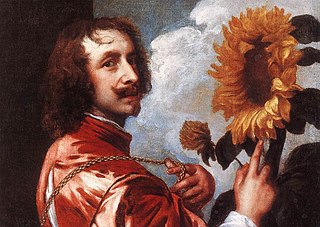
Sir Anthony van Dyck was a Flemish Baroque artist who became the leading court painter in England after success in the Spanish Netherlands and Italy.
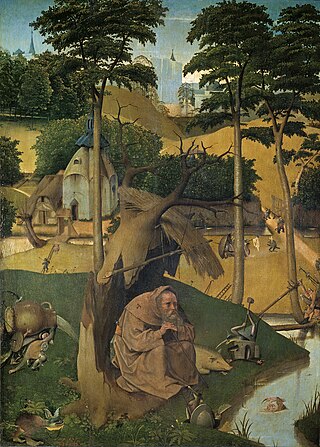
The Temptation of St. Anthony is a painting of disputed authorship, attributed to either Hieronymus Bosch or a follower. It is now in the Museo del Prado, in Madrid.

Jacob Peter Gouwy or Jacob Peter Gowy was a Flemish Baroque painter of history paintings and portraits. He collaborated with Peter Paul Rubens and spent time in England where he was active as a portrait painter. As the creator of a large picture of a horse painted in England he can be considered one of the pioneers of the genre of portraits of horses.

Equestrian Portrait of Charles V is an oil-on-canvas painting by the Italian Renaissance artist Titian. Created between April and September 1548 while Titian was at the imperial court of Augsburg, it is a tribute to Charles V, Holy Roman Emperor, following his victory in the April 1547 Battle of Mühlberg against the Protestant armies.

Jan Roos, was a Flemish artist who, after training in Antwerp, mainly worked in Italy where he was called Giovanni Rosa. He was known for his still life paintings of flowers and vegetables, mythological and religious scenes and portraits. His style of still life painting had an important influence on the art of the local painters of the Genoese school.

Entry of Christ into Jerusalem is a 1617 oil painting by Flemish artist Anthony van Dyck, located in the Indianapolis Museum of Art, which is in Indianapolis, Indiana. It depicts Jesus entering Jerusalem as described in the Gospels, the event celebrated on Palm Sunday.

The Adoration of the Magi is a very large oil painting by the Flemish Baroque painter Peter Paul Rubens. He first painted it in 1609 and later gave it a major reworking between 1628 and 1629 during his second trip to Spain. It is now in the Museo del Prado in Madrid.

The Crowning with Thorns is a 1618–1620 painting by Anthony van Dyck. He produced it aged 20 during his first Antwerp period, when he was the main studio assistant and pupil of Peter Paul Rubens. It shows Rubens' influence in its relatively sombre palette, chiaroscuro and highly realistic portrayal of musculature. He seems to have completed it early during his stay in Italy, since it also shows the influence of Titian and other Venetian painters in Jesus' face.

The Lamentation over the Dead Christ is a 1634-40 painting by the Flemish artist Anthony van Dyck. One of his last treatments of the subject, it is now in the Bilbao Fine Arts Museum, having entered it in 1985. It was previously in the collection of Henry Pelham-Clinton, 7th Duke of Newcastle, before later passing into the Valdes Izaguirre collection.
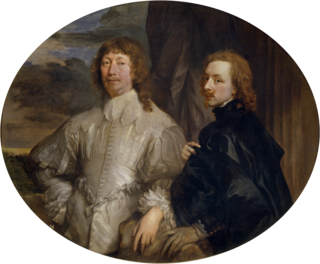
Self-portrait with Sir Endymion Porter is a self-portrait by Anthony van Dyck, showing him with his patron Sir Endymion Porter.

Peeter Symons or Peeter Simons was a Flemish painter only known for his collaboration with Rubens in 1636 on the commission from the Spanish king Philip IV of Spain to create a series of mythological paintings to decorate the Torre de la Parada, a hunting lodge of the king near Madrid.
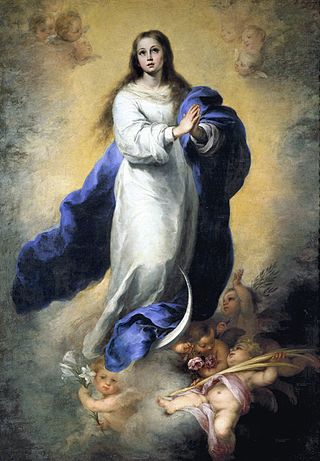
The Immaculate Conception of El Escorial is a circa 1660–1665 oil religious painting by the Spanish Baroque artist Bartolomé Esteban Murillo, now in the Museo del Prado in Madrid. Murillo's many artistic depictions of the immaculate conception of the Virgin Mary were enormously influential on later art. This painting is regarded as one of his best. It was earlier identified as the Immaculate Conception of the Granja due to a mistaken understanding of its history.

The collection of twenty-eight British paintings in the Museo del Prado is one of only two significant collections of British art in Spain - the other is the Museo Lázaro Galdiano, a private collection influenced by the personal taste of Paula Florido, the wife of its founder José Lázaro Galdiano. There is little British art in the former Spanish royal collection due to the English and Scottish Reformations and the ensuing tensions between Spain, England and Scotland. The works entered the collection through both purchase and donation, two in the 1880s and the rest mostly in the 20th century other than two at the end of the 19th century.

Diana and a Nymph Surprised by a Satyr is a 1622-1627 oil on canvas painting resulting from a collaboration between Anton van Dyck and Frans Snyders.

Saint Rosalia is a c.1625 oil on canvas painting by Anthony van Dyck. Originally owned by Giovan Francesco Serra di Cassano, it was bought by Philip IV of Spain via his Viceroy of Naples Gaspar de Bracamonte in 1664 and is now in the Museo del Prado in Madrid

Saint Rosalia Interceding for the City of Palermo is an oil on canvas painting of Saint Rosalia by Anthony van Dyck, now in the Museo de Arte de Ponce in Puerto Rico, which acquired it at auction at Sotheby's in London on 7 December 1960. It is sometimes dated to 1629 when the artist was back in Antwerp and sometimes to 1624-1625 whilst the artist was quarantined in Palermo, Sicily.
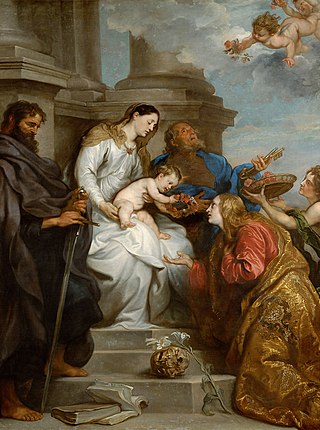
The Coronation of Saint Rosalia or Madonna and Child with Saints Rosalia, Peter and Paul is an oil on canvas painting made by Anthony van Dyck in 1629.

The Brazen Serpent is a 1618-1620 oil on canvas painting by Anthony van Dyck, now in the Museo del Prado in Madrid. It shows the Biblical story told in Numbers whereby Moses raised a bronze image of a serpent to the Israelites. It was first recorded in 1764, when it was chosen from Juan Kelly's collection in Madrid for Charles III of Spain by Anton Raphael Mengs.